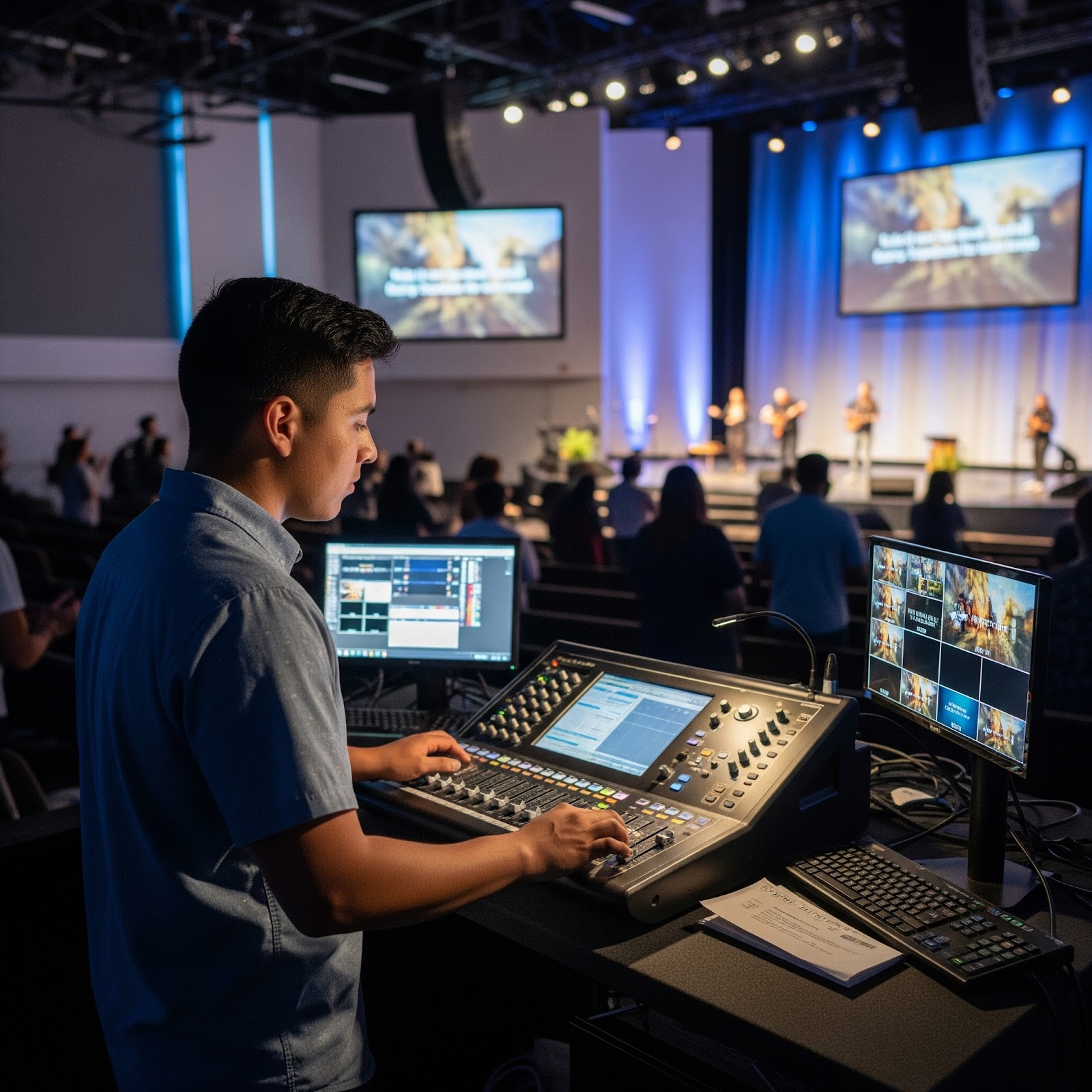Autumn is on its way, and church technology systems face their annual stress test. The surge in attendance, expanded programming, and heightened expectations can expose even minor technical vulnerabilities, potentially derailing worship experiences. No one wants to troubleshoot when the focus should be on ministry.

To help prepare your digital church infrastructure for fall programming, this guide explores steps for evaluating and fortifying your systems, helping your tech ecosystem operate invisibly while ministry leaders focus on the big stuff, like nurturing spiritual growth and building a supportive church community.
Key takeaways
- Proactive technology maintenance during late summer creates a foundation for smooth operations throughout the entire ministry year, preventing disruptions during critical fall programming.
- Comprehensive system audits involving multiple ministry departments reveal hidden pain points and potential failures before they impact worship experiences.
- Cloud-based solutions dramatically reduce setup time and technical complications, allowing ministry leaders to focus on relationship-building rather than troubleshooting.
- Implementing offline capabilities and standardized processes across all ministry areas for consistent experiences even during unexpected technical challenges.
Assessing your current tech ecosystem
Before you start talking expensive upgrades or complicated modifications, take a systematic inventory of your church's existing technology landscape. You might be surprised, because in many cases, churches discover they already own most of the powerful tools they need. The real trick is a simple case of optimization or proper configuration to meet their needs.
Getting multiple ministry departments involved in this assessment proves invaluable. Your children's pastor might identify streaming bottlenecks that IT staff never encounter, while your worship leader could highlight audio issues that only surface during specific parts of the service. These diverse perspectives paint a complete picture of your technology ecosystem's health.
The weight of the demands of fall programming add another layer to this evaluation. Between back-to-school events, holiday productions, and increased attendance, your systems will face pressures far beyond typical Sunday operations. What works smoothly for summer services might buckle under the weight of autumn's expanded ministry calendar. Taking time now to evaluate will save you countless headaches later.
Optimizing your audio-visual equipment
Here is a surprising truth about church tech failures: most stem from basic maintenance oversights rather than actual equipment malfunctions. A missing cable connection or outdated firmware often lurks behind what appears to be a major system breakdown. Simple issues such as these can create major Sunday morning stress if not addressed proactively.
Sound systems deserve particular attention as summer transitions to fall. The shift in seasonal humidity can subtly alter your worship space's acoustics, affecting everything from microphone placement to speaker performance. What worked perfectly in July might need fine-tuning by September. So, plug in the speakers and test out the sound to be sure sermons are crisply audible in every corner of your church, for every member of your congregation.
Next up, lighting. Crisp fall sunlight streaming through stained glass windows creates new challenges for visual presentations. Testing projectors and displays under various lighting conditions helps identify potential visibility issues before they impact your services. Good back-to-school church ideas should involve a few practice sermons to check how things will run when reality and routine kick in post-summer, as inadequate or glitchy lighting can distract congregants, hinder livestream visibility, and create inconsistencies across venues. Verify presets, test automation features, and replace outdated bulbs or malfunctioning fixtures.
Fall programming often introduces elements that stretch your AV capabilities in unexpected ways. That Christmas pageant might require additional wireless microphones, while new teaching series could demand more sophisticated presentation capabilities than your summer schedule required. Taking stock now means you will be ready when these special moments arrive.

Secure rock-solid Wi-Fi and streaming capabilities
Churches often underestimate how attendance fluctuations affect network performance. As families return from summer travels, your Wi-Fi infrastructure suddenly needs to handle dozens, or even hundreds, more devices attempting to connect during services. From congregants checking in via mobile apps to volunteers accessing service schedules or streaming media, this surge in demand can quietly strain your system. Though initially invisible, this strain can lead to very visible problems if not addressed.
Dead zones in your building frustrate both staff and visitors trying to access digital resources. The solution starts with placing wireless access points (WAPs) for full coverage throughout your facility, including lobbies, classrooms, and fellowship areas. Strategic placement these points eliminates connectivity black holes, guaranteeing consistent access throughout your facility. But placement alone is not enough, and regular monitoring helps identify areas where signal strength degrades over time.
When streaming becomes an integral part of your ministry strategy, whether for Sunday services, Bible studies, or youth programming, your bandwidth requirements increase dramatically. Unlike basic web browsing or email, high-quality live video demands significant upload speeds and network stability. Without the right infrastructure, buffering, lag, or dropped connections can become common frustrations for remote viewers. And in a hybrid ministry environment, a choppy or unreliable stream risks excluding online participants from the worship experience entirely. It’s the digital equivalent of showing up to a locked church door.
Network security can’t be an afterthought, especially as churches increasingly rely on digital tools for worship, administration, and outreach. Regular firmware updates and security patches for your routers, firewalls, and connected devices are essential for protecting sensitive church data, including donor information, staff credentials, and livestream content. Neglecting these updates leaves your systems vulnerable to cyber threats that compromise your data and disrupt your streaming capabilities during high-impact services. A proactive approach to cybersecurity keeps your ministry protected and your focus right where it should be: on your congregation.
Revolutionizing classroom media delivery
The days of racing between children's ministry rooms with USB drives are numbered. Though traditional, this outdated approach creates wildly inconsistent experiences across classrooms while setting up volunteers for frequent technical difficulties. You don't want to see your volunteers spending precious minutes troubleshooting instead of connecting with kids.
Cloud-based platforms like Playlister eliminate the Sunday morning media scramble. Instead of hunting down missing files, troubleshooting stubborn computers, or preparing their hearts for ministry, teachers can focus on welcoming children. With just a few clicks, your entire curriculum is ready to go across every classroom.
Modern families bring high expectations shaped by their children's experiences in schools, entertainment, and engagement. When church media feels dated or glitchy, it creates a disconnect that can hinder engagement with the message. Today's kids respond to quality experiences that feel relevant to their digital-native lives.
The standardization of media delivery systems across classrooms and campuses removes variables that often lead to technical disruptions. During the busy fall ministry season, this consistency plays a key role in maintaining quality experiences across expanded programming schedules.
Streamlining volunteer training and access
Complex technology systems create a silent barrier to volunteer engagement. When potential helpers fear looking foolish with unfamiliar equipment, they are less likely to step forward and serve. But intuitive interfaces flip this dynamic, dramatically reducing both training time and anxiety.
Playlister's drag-and-drop playlist creation requires just five minutes of training for most volunteers. That is the difference between someone confidently serving in ministry or staying in the pews out of technological intimidation. Who would not prefer a system that anyone can learn in minutes?
The fall influx of new volunteers magnifies the importance of standardized, simple processes. When every ministry area uses consistent technology approaches, volunteers can confidently serve wherever needed without learning multiple systems. This flexibility is priceless during busy ministry seasons.
Permission-based access systems strike the perfect balance between empowerment and protection. Volunteers gain the confidence of controlling exactly what they need, while churches maintain security over sensitive data, presentation content, and protection.
Quick-reference guides with clear screenshots transform potential panic moments into solved problems. Visual aids dramatically reduce emergency calls to church staff during busy Sunday mornings. A simple guide can mean the difference between a smooth service and a frantic tech emergency.
Refreshing digital signage for maximum impact
Static digital signage wastes valuable communication real estate. Yet too often, churches set their displays once and forget them, missing countless opportunities to promote fall programming and create fresh impressions for returning families.
The visual quality of your digital signage speaks volumes about your church's attention to detail. When crafted thoughtfully, slides elevate communication and create professional first impressions that shape how visitors perceive your entire ministry. What message does outdated or poorly designed signage send to first-time guests?
Because we live in a visually-oriented society, dated or poorly designed digital displays can inadvertently signal that a church is out of touch. But thoughtful, contemporary design tells visitors you understand and value clear communication in their language. It is like speaking the visual language your community already understands.
Centralized management of digital signage eliminates the brand inconsistencies that often crop up when multiple staff members update different displays. A coordinated approach keeps your church's visual voice clear, professional, and consistent across every screen in your facility. When every sign tells the same story, your message becomes that much more powerful.
Implementing centralized content management
The hidden cost of decentralized content systems bleeds churches of countless ministry hours. When media files scatter across multiple devices, email attachments, and various storage drives, chaos inevitably follows. We have all been there, hunting through folders trying to find that one perfect video.
Playlister's cloud-based platform transforms this scattered approach into a streamlined operation. When content synchronizes automatically across all devices, the time previously spent on manual updates can be redirected to actual ministry. Imagine reclaiming those hours for relationship-building instead of file management.
Fall curriculum transitions become remarkably smooth when new content can be scheduled weeks in advance. This capability to plan ahead brings peace of mind during busy season changes, so every classroom and campus starts new programs simultaneously. No more wondering if every room got the update.
Analytics give ministry leaders insight into content usage patterns across their church ecosystem which help identify what is working, what needs adjustment, and enabling data-driven ministry decisions. Book a demo with Playlister to discover how centralized content management can transform your church operations and free your team to focus on ministry instead of technical logistics.

Preparing for the unexpected with offline capabilities
Internet outages transform from minor inconveniences into ministry emergencies when all your content depends on live connections. During high-attendance fall events and services, these disruptions can derail carefully planned experiences. We have all experienced that sinking feeling when the internet drops at the worst possible moment.
Systems with robust offline functionality give church leaders peace of mind when connectivity fails unexpectedly. Instead of scrambling for backup plans, ministry continues smoothly even when the internet does not cooperate. Your team can stay focused on people rather than panicking about technology.
Fall and winter months often bring weather-related disruptions that can affect internet stability. When weather challenges arise, offline capabilities become necessary for maintaining ministry continuity throughout these demanding seasons. When storms roll in, your ministry can continue without missing a beat.
Playlister's offline mode exemplifies this principle in action. Content continues playing seamlessly even when internet connections drop, preventing technical distractions from interrupting worship, and learning experiences. This reliability means your ministry remains steady regardless of connectivity challenges.
Transform your fall ministry season with proactive tech solutions
The investments you make now in assessing and upgrading church technology systems yield dividends far beyond the fall season. A robust technical foundation supports ministry growth throughout the entire school year, enabling your ministry to embrace the future of church, rather than managing recurring technical challenges.
The most effective church technology operates like a skilled stagehand – invisible to the congregation, yet playing an indispensable role in the performance. When systems work reliably in the background, ministry leaders can fully embrace their true calling of connecting people with purpose, and pointing them toward Christ. After all, church tech is really about creating distraction-free environments where life change can happen.
Do not let preventable technical issues stand between your congregation and meaningful worship experiences this fall. With thoughtful preparation and the right tools, your church can create seamless ministry moments that keep the focus where it belongs, on growing disciples, and building community.



